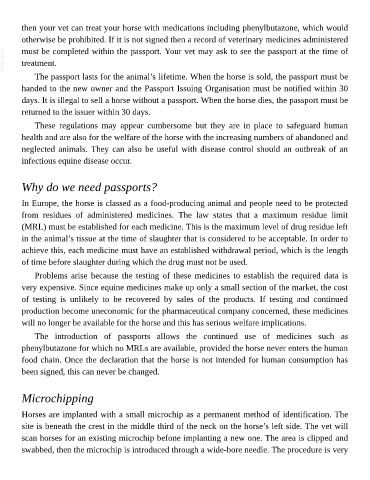Page 1116 - The Veterinary Care of the Horse
P. 1116
then your vet can treat your horse with medications including phenylbutazone, which would
otherwise be prohibited. If it is not signed then a record of veterinary medicines administered
VetBooks.ir must be completed within the passport. Your vet may ask to see the passport at the time of
treatment.
The passport lasts for the animal’s lifetime. When the horse is sold, the passport must be
handed to the new owner and the Passport Issuing Organisation must be notified within 30
days. It is illegal to sell a horse without a passport. When the horse dies, the passport must be
returned to the issuer within 30 days.
These regulations may appear cumbersome but they are in place to safeguard human
health and are also for the welfare of the horse with the increasing numbers of abandoned and
neglected animals. They can also be useful with disease control should an outbreak of an
infectious equine disease occur.
Why do we need passports?
In Europe, the horse is classed as a food-producing animal and people need to be protected
from residues of administered medicines. The law states that a maximum residue limit
(MRL) must be established for each medicine. This is the maximum level of drug residue left
in the animal’s tissue at the time of slaughter that is considered to be acceptable. In order to
achieve this, each medicine must have an established withdrawal period, which is the length
of time before slaughter during which the drug must not be used.
Problems arise because the testing of these medicines to establish the required data is
very expensive. Since equine medicines make up only a small section of the market, the cost
of testing is unlikely to be recovered by sales of the products. If testing and continued
production become uneconomic for the pharmaceutical company concerned, these medicines
will no longer be available for the horse and this has serious welfare implications.
The introduction of passports allows the continued use of medicines such as
phenylbutazone for which no MRLs are available, provided the horse never enters the human
food chain. Once the declaration that the horse is not intended for human consumption has
been signed, this can never be changed.
Microchipping
Horses are implanted with a small microchip as a permanent method of identification. The
site is beneath the crest in the middle third of the neck on the horse’s left side. The vet will
scan horses for an existing microchip befone implanting a new one. The area is clipped and
swabbed, then the microchip is introduced through a wide-bore needle. The procedure is very

